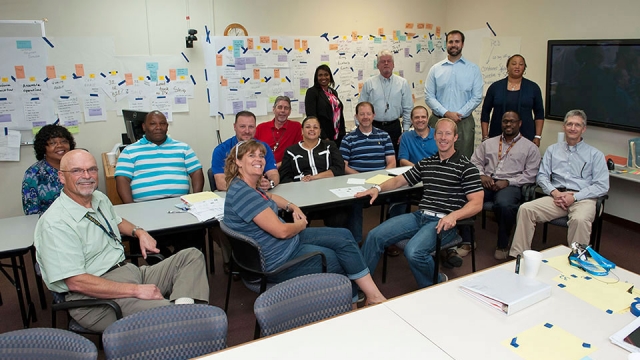Becoming one team, better together
 An integrated team of Pantex and Y-12 employees (some members shown here) work on the beginning stages of the container improvement initiative.
An integrated team of Pantex and Y-12 employees (some members shown here) work on the beginning stages of the container improvement initiative.
For Pantex and Y-12, delivering the mission as one team is more than the sum of its parts; it’s a shared responsibility to find smarter ways to integrate resources, eliminate redundancies, tackle shared problems and break up bottlenecks. That, in turn, helps to better meet mission requirements at both sites.
With more than a thousand miles separating the sites and decades of operating independently, becoming one team hasn’t been easy, but it makes sense. The production sites play an essential role in the nation’s defense and nonproliferation strategy. The two sites’ missions are intertwined and now so are many of their operations.
Several Consolidated Nuclear Security, LLC (CNS) organizations are playing an important role in integrating the sites’ processes and systems. “Our CNS team is accomplishing integration on a scale that has never been done before within the Nuclear Security Enterprise,” said Darrell Graddy, CNS’s vice president for Operations Support. “We’ve already made a lot of progress, but there is still more that can be done.”
Graddy said the biggest challenge is to “raise the standards in everything we do to a level reflective of our mission success.”
Following are a few examples of how CNS employees are fostering a collaborative work environment.
Mission first
CNS synchronized weapons baseline schedules for Pantex and Y-12. Both sites jointly reworked the B61-12 Life Extension Program project schedules to include bottom up resource estimates and integration of key subprojects. The team also consolidated the Earned Value Management System — the method used to plan and measure the cost and progress of large projects — on both unclassified and classified platforms.
“The result of these efforts was the successful B61 integrated baseline review at both sites,” said James Fine, senior director of Enterprise Planning and Controls.
Integrated mission planning
Another example of cross site collaboration is CNS’s work with the National Nuclear Security Administration, Sandia National Laboratories (SNL) and the National Security Campus in Kansas City on the Logistics, Accountability, Planning and Scheduling project, or LAPS. LAPS encompasses the functions that support many aspects of the Nuclear Security Enterprise weapons production business. The integrated project team is working to deliver new processes and a computer system of integrated technology and data to replace aging applications.
The new system, a first for the Nuclear Security Enterprise, will improve planning capabilities, reduce costs and provide for operational efficiencies throughout the supply chain. “CNS is responsible for leading development of planning and scheduling aspects, and SNL is responsible for accountability and logistics. Together in 2015, we completed a joint proof of concept effort in two closely coordinated project plans,” said John Hudson, senior program manager in Enterprise Planning and Controls. “This laid the groundwork for system requirements definition to proceed in 2016.”
Prioritizing infrastructure upgrades
The National Nuclear Security Administration (NNSA) recently designated Lawrence Livermore National Laboratory, Pantex and Y-12 as BUILDER Centers of Excellence.
BUILDER, a knowledge-based condition assessment software developed by the U.S. Army Corps of Engineers, is being implemented across the NNSA complex to help plan for maintenance and prioritize infrastructure upgrades. The three site team has been working to gather data on every facility in the Nuclear Security Enterprise. All the data — including building square footage; number of windows and doors; and type and condition of foundation, roofing and flooring — have been entered into BUILDER.
“BUILDER will provide an enterprise level understanding of the condition of existing facilities and will allow for a risk-based approach to future infrastructure needs,” said Jane Nations, Y-12 site master planner. “CNS was selected as a Center of Excellence because of our willingness to investigate and share methods to make the NNSA implementation process more efficient.”
